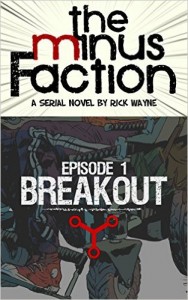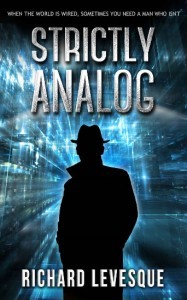 In Richard Levesque’s Strictly Analog I was pleased to find an innovative story of provocative imagination. Set in not so distant future Los Angeles and Orange County, California, the story presents itself as a noir private investigator romp. Indeed, the beginning may seem to meander a bit to show us the main character doing his strictly analog shtick before the meat of the action drops on our table. But what we have experienced during the first course provides us with a seamless all-show-very-little-tell story that introduces us into quite a world.
In Richard Levesque’s Strictly Analog I was pleased to find an innovative story of provocative imagination. Set in not so distant future Los Angeles and Orange County, California, the story presents itself as a noir private investigator romp. Indeed, the beginning may seem to meander a bit to show us the main character doing his strictly analog shtick before the meat of the action drops on our table. But what we have experienced during the first course provides us with a seamless all-show-very-little-tell story that introduces us into quite a world.
Our protagonist has thus far managed to survive in a society where corporations run for elective office—governor even—everyone is interconnected through a myriad of electronic to human interfaces, which in turns means those who can tap all their data streams can see what they can. Who needs surveillance cameras if you can access what each person can see? But our gumshoe has made it his brand to avoid all that connectivity. How? By staying strictly analog. He doesn’t avail himself of all those wearable and built-in devices, which means he can stay off-grid, and his clients like it that way just fine.
Things would keep going that way if not for his daughter landing in jail for the murder of her secret police boyfriend. As her father does his level best to find evidence of her innocence before she’s deported out of California—and not to Mexico—he will have to navigate obstacles and dangers that challenge his ability to stay strictly analog.
For fear of spoiling the story, I’ll leave it there, going on to say, I loved this story. Told in first person, we get to know our protagonist from the inside out. He takes us along his journey with a wonderful, evocative voice that is just right—not over the top, but commanding our attention. The narrative paints this world he lives in with lively color and gritty texture. We also come across a supporting cast of characters that are real and distinct. Above all, though, through a compelling page-turner, we explore a world with many advances, and a lot of pain. Apparently technology doesn’t solve our innermost needs. We find a lot of angst here, a lot of loneliness, perhaps even despair, all of it interconnected at the speed of light.
If you were to strip this story of all its technological elements, you would be left with a pedestrian procedural. But that’s just it. You can’t do that. The case our protagonist solves inextricably intertwines and integrates with the technology of the day. You have to really sink into this world and its tech components to get this story. And that, perhaps more than anything, is why I loved this story.
Now… will there be a sequel?
About The Reviewer
 It took Eduardo Suastegui a while to discover he was an artist trapped in an engineer’s body. With formal education in math and science, affirmed through hands-on engineering experience in designing, building, and integrating gadgets of varying complexity, he always kept daydreaming. Throughout his life, that daydreaming fed technological innovation.
It took Eduardo Suastegui a while to discover he was an artist trapped in an engineer’s body. With formal education in math and science, affirmed through hands-on engineering experience in designing, building, and integrating gadgets of varying complexity, he always kept daydreaming. Throughout his life, that daydreaming fed technological innovation.
More recently, that daydreaming has engendered stories about hackers, rogue AIs, and space travel, with more than a few stories about a dog trainer and her K9s sprinkled in. Eduardo loves to dive into fast-flowing, character-driven stories. With each of the books he reads or writes, he hopes to continue that adventure.
More than anything, through his writing, he hopes to connect with readers. He seeks to share a piece of himself with those who pick up and delve into his work.
Learn more about Eduardo and his work at http://eduardosuastegui.com/
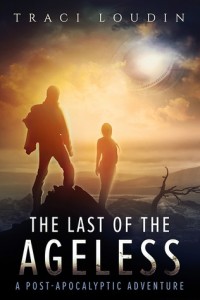 You know how sometimes a book is long and it feels longer? This one was long, but flew by. Traci Loudin painted pictures in my mind of very different groups and tribes all co-existing in a post-apocalyptic world, some peacefully, some not.
You know how sometimes a book is long and it feels longer? This one was long, but flew by. Traci Loudin painted pictures in my mind of very different groups and tribes all co-existing in a post-apocalyptic world, some peacefully, some not. Husband, father, and researcher, Ryan Toxopeus spends his free time working on his epic fantasy trilogy, Empire’s Foundation. He started writing the first book, A Noble’s Quest, in 2010 and fell in love with all aspects of storytelling. He focuses on fast paced, character driven plots. His motto: “If I’m bored writing it, others will be bored reading it.”
Husband, father, and researcher, Ryan Toxopeus spends his free time working on his epic fantasy trilogy, Empire’s Foundation. He started writing the first book, A Noble’s Quest, in 2010 and fell in love with all aspects of storytelling. He focuses on fast paced, character driven plots. His motto: “If I’m bored writing it, others will be bored reading it.”
 Samantha Bryant is a middle school Spanish teacher by day and a mom and novelist by night. That makes her a superhero all the time. Her debut novel, Going Through the Change: A Menopausal Superhero Novel is now for sale by Curiosity Quills.
Samantha Bryant is a middle school Spanish teacher by day and a mom and novelist by night. That makes her a superhero all the time. Her debut novel, Going Through the Change: A Menopausal Superhero Novel is now for sale by Curiosity Quills.

 It took Eduardo Suastegui a while to discover he was an artist trapped in an engineer’s body. With formal education in math and science, affirmed through hands-on engineering experience in designing, building, and integrating gadgets of varying complexity, he always kept daydreaming. Throughout his life, that daydreaming fed technological innovation.
It took Eduardo Suastegui a while to discover he was an artist trapped in an engineer’s body. With formal education in math and science, affirmed through hands-on engineering experience in designing, building, and integrating gadgets of varying complexity, he always kept daydreaming. Throughout his life, that daydreaming fed technological innovation.

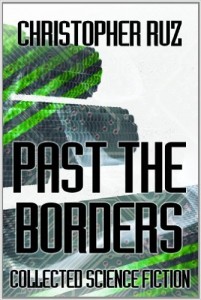
 A.M. Harte is a London-based speculative fiction enthusiast and chocolate addict whose work includes the dark fantasy novel “Above Ground” and the zombie love collection “Hungry For You”. She is excellent at missing deadlines, has long forgotten what ‘free time’ means, and enjoys procrastinating at
A.M. Harte is a London-based speculative fiction enthusiast and chocolate addict whose work includes the dark fantasy novel “Above Ground” and the zombie love collection “Hungry For You”. She is excellent at missing deadlines, has long forgotten what ‘free time’ means, and enjoys procrastinating at 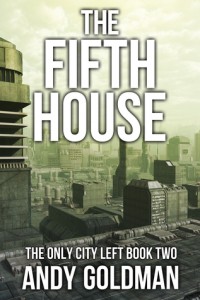
 Hush Money is the promising debut of Susan Bischoff‘s Talent Chronicles series, a YA urban fantasy series that — rather refreshingly — avoids any mention of vampires or sparkling (because teens are interested in more than just blood-sucking).
Hush Money is the promising debut of Susan Bischoff‘s Talent Chronicles series, a YA urban fantasy series that — rather refreshingly — avoids any mention of vampires or sparkling (because teens are interested in more than just blood-sucking).